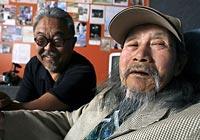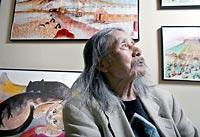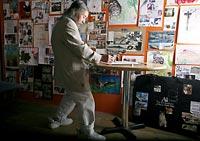The nine lives of a resilient artist

The day before his exhibit opened at the Wing Luke Asian Museum, Jimmy Tsutomu Mirikitani sat in a rocking chair surrounded by his art, dozing while people passed around him.
But the nap was just a momentary diversion, as the youthful 86-year-old quickly roused himself and started drawing at a nearby table. In fact, said artist and exhibit curator Roger Shimomura, Mirikitani had stayed up drawing half the night before on their drive up from Tule Lake, the former Japanese internment camp in California.
Though Mirikitani often seems out of breath, he doesn't mince words when he does talk. And when he draws he makes strokes with a concentration that internment, homelessness and even a terrorist attack have failed to shake.
I asked Mirikitani about particular subject matter. The drawings, done with black pen and bright pastels, have repetitive motifs. A cat lies next to some fish and fruit, licks of red flame engulf the A-Bomb Dome at Hiroshima, and the jagged peak of Castle Rock rises above bleak barbed wire at Tule Lake.
He answered in a gruff English that Linda Hattendorf, who had spent months creating a film about him, clarified. When he talked he often closed his eyes as if reaching back for words.
The fishes and the fruit — persimmons — are of a kind specific to Hiroshima, he said. Hiroshima, site of the first atomic bombing, was the home of Mirikitani's relatives. Though Mirikitani was born in Sacramento, he went back with his family to Hiroshima to attend school, returning to Seattle just before the start of World War II. His mother had died before but her family perished in the blast.
I asked about the cats and he recalls a 6-year-old boy incarcerated with him at Tule Lake. The boy, who asked him to draw a cat, died in the camp later. I pointed out the peak of Castle Rock. "People buried there," he said.
Mirikitani was incarcerated at Tule Lake at 25 years old. His sister Kazuko was sent to Minidoka. His father had stayed in Japan. Tule Lake was a chance destination for Mirikitani. It was only later that internees specifically segregated for refusing to declare loyalty to the United States were sent to the camp. Tule Lake, the largest of the internment camps, was also the most harshly run as its internees were considered enemies of the United States.
Immediate bond
Shimomura discovered Mirikitani on eBay, the Internet auction site, when the keywords "Japanese internment camp" brought up a drawing of a cat by Mirikitani. "The description said [he was] a homeless Japanese-American man who lives in Washington Square Park in New York," said Shimomura. "It also said that he does drawings of internment camps."
The year was 1999. Shimomura travels to New York frequently and looked for Mirikitani on his next trip. It was rare enough, he said, to hear about a homeless Japanese person. "I went to Washington Square and there he was. He was pushing two shopping carts around. And there were his drawings. He was sitting there with two overcoats, and was quite cold." A friendship quickly grew.
"We immediately bonded when I said that I, too was Japanese American, I too was sent to internment camp when I was a child. And I too was an artist and made artwork about that. So from that point on whenever I'd go to New York I'd make it a point to go to Washington Square to see Jimmy. I would buy his work, give him money, bring him sushi, give him art supplies."
"Until one day he was no longer there. He disappeared. I thought perhaps he passed away."
Tragedy is turning point
Then in early 2001 Shimomura received an e-mail from Linda Hattendorf, a filmmaker who had decided to make a film about Mirikitani. She told Shimomura that Mirikitani had moved from Washington Park to the outside of a Korean grocery store in the Soho district.
Then came the attacks on the World Trade Center. Hattendorf, who lived near the buildings, went out to the streets with her camera. Everyone looked up at the World Trade Center building, and at the wing-shaped hole left by the plane. Mirikitani was at his usual spot, facing away from the scene, drawing a cat. When Hattendorf checked in on him the next day, however, he had begun to draw the swirls of fire, dark clouds, and dead bodies in his surroundings. Only a flimsy mask protected him from the toxic dust and Hattendorf couldn't leave him.
"In the same way that the walls of the World Trade Center came down," she said, "the walls between people also cracked. I couldn't see him spending the night like that, so took him to live with me." Hattendorf continued filming as she helped him reconnect with long-lost family. His sister turned out to live in Seattle just two blocks from Shimomura's condo.
Hattendorf also investigated the status of his citizenship. Like other internees at Tule Lake, Mirikitani renounced his U.S. citizenship under pressure. His citizenship was reinstated in 1959, but because he had moved around so much he never got the letter. Hattendorf helped him get his own apartment as well as make a pilgrimage to Tule Lake. Her film "The Cats of Mirikitani" premiered at the Tribeca Film Festival this year, winning an Audience selection award. A shortened version will be broadcast on PBS in May 2007.
On one of their first meetings in New York, Shimomura described how Mirikitani was so absorbed in the internment experience. "Yes, dammit. People put 10,000 of us there ... " Mirikitani would blurt out while doing his drawings in the streets. "He was enraged," said Shimomura.
But the latest pilgrimage seemed to have changed him, said Hattendorf. "In Tule Lake, he said, 'Give flower to dead people. So they have a good sleep.' " Now that he's had a chance to lay flowers at the memorial, he says he is "not mad anymore." Another of Mirikitani's motifs is a ginger flower of a type said to bloom only once every hundred years. His art, unrelenting, serves as a faithful watch for rare hope.
Lucia Enriquez: lucia_enriquez@hotmail.com


Now showing
Jimmy Tsutomu Mirikitani through Sept. 17, Wing Luke Asian Museum, 11 a.m.-4:30 p.m. Tuesday through Friday, noon-4 p.m. Saturday and Sunday. 407 Seventh Ave. S., Seattle (206-623-5124 or wingluke.org).